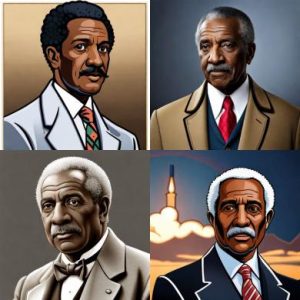George Washington Carver was a prominent scientist, inventor, and educator whose groundbreaking work in agriculture continues to inspire people worldwide. In celebration of his birthday, we will explore Carver’s background, career timeline, and the reasons we admire him.

We also uncover some surprising facts about the renowned scientist and answer frequently asked questions. Join us in commemorating the incredible George Washington Carver!
Fast Facts
- Full Name: George Washington Carver
- Date of Birth: Circa 1864 (exact date unknown)
- Birthplace: Diamond, Missouri, United States
- Occupation: Agricultural scientist, inventor, educator
- Years Active: 1890s–1943
- Died: January 5, 1943
Background
George Washington Carver was born into slavery around 1864 in Diamond, Missouri. His mother, Mary, was owned by Moses and Susan Carver. Shortly after George’s birth, he and his mother were kidnapped by slave raiders, but only George was eventually found and returned to the Carver family. Moses and Susan Carver raised George and his brother James as their own, educating them and encouraging their intellectual pursuits.
Carver displayed a keen interest in plants from a young age and became known as the “Plant Doctor” in his community. He went on to attend Iowa State Agricultural College (now Iowa State University), where he earned a bachelor’s degree in agricultural science in 1894 and a master’s degree in 1896.
Career Timeline
- 1896: Carver was invited by Booker T. Washington to join the faculty at Tuskegee Institute (now Tuskegee University) in Alabama. He would remain there for 47 years, teaching and conducting research on agricultural science.
- 1900s: Carver’s research focused on helping Southern farmers, particularly African American sharecroppers, improve their crop yields and soil quality. He advocated for crop rotation and the planting of nitrogen-fixing plants like peanuts and sweet potatoes.
- 1914: Carver presented his research at the National Conference on Agricultural Science, highlighting the potential of peanuts as a cash crop.
- 1920s: Carver gained national and international recognition for his work in agriculture, receiving numerous awards and honors. He also worked with major figures like Henry Ford and Thomas Edison.
- 1930s: Carver became an influential figure in the “chemurgy” movement, which aimed to create new industrial uses for agricultural products.
- 1943: George Washington Carver passed away on January 5, 1943.
Why We Love George Washington Carver
- Innovation: Carver was an innovative scientist and inventor who developed more than 300 products from peanuts, including cosmetics, dyes, plastics, and even gasoline. His work transformed the agricultural landscape of the American South.
- Determination: Despite the significant challenges he faced throughout his life, including being born into slavery and facing racial discrimination, Carver persevered in his pursuit of education and scientific advancement.
- Educator: As a teacher at Tuskegee Institute for nearly half a century, Carver inspired and educated countless students, passing on his knowledge and passion for agricultural science.
- Compassion: Carver’s research was driven by a desire to help struggling farmers, particularly African American sharecroppers in the South. His innovations improved the lives of countless individuals and communities.
- Legacy: George Washington Carver’s work continues to inspire new generations of scientists, inventors, and educators, who admire his commitment to innovation, determination, and compassion. His legacy lives on through the numerous institutions and programs dedicated to promoting agricultural science and education.
5 Surprising Facts About George Washington Carver
- Artistic Talent: Carver was a talented painter and sketch artist, even earning a scholarship to study art at Simpson College in Iowa before transferring to Iowa State Agricultural College to pursue agricultural science.
- Vegetarian: Carver was a vegetarian, consuming a diet primarily consisting of fruits, vegetables, and nuts. He believed in the health benefits of plant-based foods and even developed recipes using peanuts and other plant-based ingredients.
- Honorary Doctorates: Despite not having a doctorate degree himself, Carver received several honorary doctorate degrees in recognition of his significant contributions to agricultural science and education.
- Stamp Recognition: In 1948, George Washington Carver became the first African American to be featured on a U.S. postage stamp, commemorating his immense impact on American agriculture and society.
- Presidential Connections: Carver corresponded with several U.S. presidents during his lifetime, including Theodore Roosevelt, Calvin Coolidge, and Franklin D. Roosevelt. He even served as an agricultural advisor to Mahatma Gandhi.
George Washington Carver’s Birthday Dates
| Year | Date | Day |
|---|---|---|
| 2023 | January 1 | Monday |
| 2024 | January 1 | Wednesday |
| 2025 | January 1 | Thursday |
| 2026 | January 1 | Friday |
| 2027 | January 1 |
*Note: George Washington Carver’s exact birth date is unknown; however, he was born around 1864.
Frequently Asked Questions
Q: When was George Washington Carver born?
A: George Washington Carver’s exact birth date is unknown, but he was born around 1864 in Diamond, Missouri.
Q: What is George Washington Carver most famous for?
A: Carver is most famous for his groundbreaking work in agricultural science, particularly his research on peanuts and the development of more than 300 products derived from them.
Q: Was George Washington Carver married?
A: No, George Washington Carver never married or had children. He devoted his life to his work in agricultural science and education.
Q: What was George Washington Carver’s role at Tuskegee Institute?
A: Carver was a professor and researcher at Tuskegee Institute for 47 years. He taught classes, conducted research, and developed innovative agricultural techniques and products to benefit farmers in the American South.
Q: What was George Washington Carver’s impact on agriculture?
A: George Washington Carver’s research revolutionized agriculture in the American South by promoting the cultivation of peanuts and other nitrogen-fixing plants, which improved soil quality and crop yields. He also developed numerous products from peanuts, creating new market opportunities for farmers.
